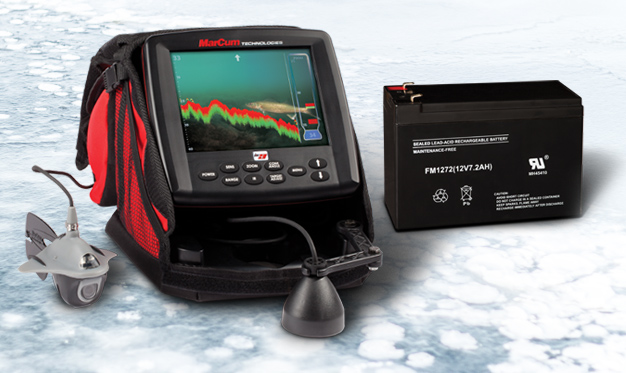
When the sky starts going scarlet before supper, that’s your sign to reach for your red MarCum soft-pack and pull your sonar out of storage.
As the days get shorter, first ice draws closer. This is the time to fetch your flasher from the garage, “fire it up and run through all the features,” says ICE FORCE Pro Tony Boshold, who runs a MarCum LX-5 [Product 'LX-5' not found!] and an LX-9 [Product 'LX-9' not found!].
“You want to start this process in late fall, not the night before your first-ice trip,” he says. “If you discover any issues, you want to give yourself plenty of time to address them and be ready to roll as soon as the ice is safe to fish on.”
If your sonar unit does not turn on, or exhibits any of these symptoms, a weak battery is most likely the culprit:
- Unit turns on, motor spins, but there are no lights
- Unit turns on, but only works for a short time
- Unit will not mark bottom, with transducer clicking (of course, when doing pre-season prep, “bottom” would be your floor)
“If you need a new battery, this is the time to get it,” Boshold says. “Consider one with more amp-hours, so you can get longer life out of it.”
The 12-volt [Product 'BATT129' not found!], sealed lead-acid batteries that MarCum units run on come in 7, 8, and 9-amp versions. The higher the amperage, the longer run-time. For most anglers, a 7-amp battery will cover an entire day on the ice. Boshold uses a 9-amp battery, which offers extended use and longer periods without a re-charge.
“I want to make sure I get a good life out of my battery, in case I do forget to charge it and I go out the next day,” he says.
Most batteries used in ice fishing electronics last about three years. All common brands are sold in standard dimensions that will fit inside your MarCum soft-pack.
After checking your battery, “next check that all your connections are good and make sure none of your clips are starting to bend or break,” Boshold says. “And double-check your down-view fin to make sure it didn’t get broken during storage.”
Then fully run your battery down and re-charge it. When rechargeable batteries sit for a long time without getting used – like over the ice fishing off-season – they lose performance hours. “You’ll still be able to charge the battery to full capacity,” Boshold explains, “but it’s actual run-time and life will shorten if you don’t regularly run it down and re-charge it.”
Over the course of the winter, store your sonar batteries indoors, at room temperature – not in the garage. Big temperature swings in an un-insulated, un-heated garage will reduce a battery’s life.
About Tony Boshold
Boshold has competed in ice fishing tournaments across the U.S. and all over the world, winning the 2005 North American Ice Fishing Circuit (NAIFC) National Championship, competing in the 2009 World Ice Fishing Championship, and then helping the 2010 USA Ice Team win the first Gold Medal a U.S. fishing team has ever won in world competition.
Since then, he’s been featured in the TV show “Ice Men,” begun guiding in and around his native Chicago and joined the ICE FORCE team. In addition to fishing tournaments, he makes numerous appearances at seminars and expos to share what he’s learned.
“I love competing, but I love the folks that come and thank me for teaching them something, too,” he says. “That is what makes it all worthwhile – the sacrifices of being on the road and cruising 10,000 miles for a season of ice fishing.”